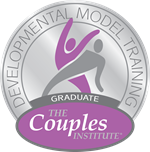How To Manage Anxiety With A Breathing Exercise by Dr Stephen Porges
/Learn how this breathing exercise (designed by Dr Stephen Porges - author of the The Polyvagal Theory) helps you manage anxiety by regulating your body.
When your body experiences anxiety it does what it’s primed to do: react to the state of fear you’re sensing.
As Stephen Porges says, “Anxiety is our higher brain structures interpreting a bodily (lower brain) response as needing a defense.”
If you’re familiar with anxiety or stress you know the heart racing, chest pounding and bodily fear that rises like a run-away elevator in your body. It can leave you lashing out with rage and anger or having to leave your immediate environment as everything swirls into an uncomfortable mix of overwhelm.
Telling yourself to relax rarely works.
Listening to others who tell you not to worry rarely works either.
How Your Body Responds To Stress And Anxiety
When your brain senses fear it activates your sympathetic nervous system. It’s all alarm bells, sirens and flashing lights alerting your body to danger … even if the ‘danger’ is being late for an important meeting, arguing with your partner, or trying to make it to work on time after dealing with an upset child.
When these alarm bells go off you’ll notice these physiological changes as blood is directed to parts of the body necessary to manage the perceived danger:
You’re breathing shifts more into the upper part of your chest
Your breaths become shorter
Your heart rate rises
Your muscles become more tense
The upper part of your face becomes flatter or has less expression
Your voice becomes more high-pitched with a narrower range of intonation
Once the danger is over your body’s parasympathetic nervous system returns your body to its equilibrium. And life goes on … until the next stressful event occurs - OR the stress you’re experiencing in your life is all pervasive and as a result is keeping your body on high alert even when there is no ‘triggering’ incident for you to feel anxious.
Why Your Personal Narrative Adds To The Problem
As your body moves into an anxious state, what you tell yourself about the meaning behind the feeling matters.
For example, you may be:
Telling yourself that you’re fearful of getting into an elevator, an aircraft or a room without windows as it triggers thoughts of a previous traumatic event
Avoiding crowded places or noisy environments as they trigger overwhelm
Hearing your inner-self suggest things that could be wrong if you see your boss/manager walking towards you (e.g. I’ve made a mistake, I’ll be sacked, someone’s complained about me, I’ve been late for meetings)
Noticing your baby or toddler waking and feeling overwhelmed at having to cope with his or her energy level, crying or not having time to complete the myriad of things things you need to do.
Having dreams that wake you causing you to feel as if you’re having a health crisis
These personal narratives may be leading you to feeling overly critical of yourself, blaming yourself, feeling a sense of shame or judging yourself as simply ‘not good enough’.
Emotional states triggered by anxiety are not voluntary, they’re programmed from an evolutionary perspective. Your brain is protecting you in a way that has kept mammals safe from the earliest of times - it’s an automatic response emanating from the oldest part of your brain - often called the reptilian brain.
Once ‘danger’ is felt, those ‘anxious’ responses ripple throughout your body - meaning that if your heart starts pounding other parts of your body (lungs, gut, muscles) will also ‘get the fear message’ and respond.
If you can manage to alter one aspect of this involuntary ripple effect, then it’s possible to return the body back to calm more quickly.
While it’s not so easy to slow your heart rate (unless you’re a practiced meditator) you can manage your breathing.
This is why Stephen Porges’ technique is simple, yet so effective
To change your physiological state so you have a more positive, regulated and appropriate response Dr Porges suggests: manipulating your breath.
While this technique is based on traditional breathing exercises, he takes it one step further by introducing the idea of ‘tricking’ your mind into slowing your breathing.
He says: When you’re experiencing tension, your hands and chest may be tightening. You’re breathing from a higher point in your chest. And these body responses are creating a physiological state that supports the feeling of anxiety.
At this point in time, the mind isn’t processing the logical answer of ‘just relax’ because you’re embodying anxiety and not taking in the social cues that could ease anxious feelings.
When experiencing a state of stress or anxiety, higher-order thinking becomes limited. If someone is experiencing anxiety they may misinterpret a person with a ‘neutral’ expression on their face as being threatening and/or judgemental.
So learning how to manage anxiety in the moment is an important skill to master as your ‘logical brain’ isn’t able to support you in the way it normally does.
Dr Porgal’s Breathing Technique:
Use this technique to ‘trick’ yourself into slowing down your breathing.
Porges suggests exhaling slowly by extending the duration of your phrases - i.e. saying more words before taking a breath. He says that many people experiencing anxiety change their speech pattern and take a breath on every other word, so by taking longer to exhale you’ll aid your body’s parasympathetic response (the part of your autonomic system that encourages you to rest and relax).
This is a great tip if you’re about to present at a meeting or give a talk and need to calm the nerves, but what about the everyday situation?
An Every Day Breathing Technique You Can Use Anywhere
I like to use a similar approach, yet with a more automatic procedure - counting.
It involves counting backward from ten to one.
As you begin, say the word ‘ten’ as slowly as you can, releasing your breath fully.
Now take a normal breath in.
Then continue with ‘nine’, saying it as slowly as you can and releasing your breath fully.
Continue in this way until you reach ‘one’ - notice the difference in your chest, gut area, shoulders, hands, facial muscles, throat and leg muscles.
ALTERNATIVE: For each number, visualise the corresponding amount of candles. As you say each number, visualise blowing out the candles in a slow and steady exhale. This helps ‘distract’ you from the source of anxiety so you focus more on your breathing and blowing out the candles instead.
A TIP FROM APPLE: Check out apple’s breathing app
USE A CHILDREN’S TOY: Remember the fun of blowing bubbles? Grab hold of a bubble blower and take a couple of minutes each day blowing bubbles.









